Tuesday, July 05, 2005
Thanks To Mt. Palomar.
The Open House was thoroughly enjoyable and ought to be repeated. The event was pretty well planned with interesting lectures by CalTech scientists at the on site museum every half hour. There were tour buses available to take visitors around the compound and food was sold by students and parents from the local school.
Clearly, more visitors than anticipated attended and there were a couple problems as a result. There weren't sufficient bathrooms around the grounds for the number of people who came. Also waits to see the 200 inch Hale telescope got very long. I waited over 3 hours to see the scope and only got in when the organizers decided to just let people in to guide themselves around the scope at the end of the day. For most of the day smaller groups were allowed in at a time and given a more guided tour. The scope is impressive enough as it is and with people stationed around the inside to answer questions, a guided tour would not really be necessary. But the positives far outweighed the negatives and credit is due to the observatory, CalTech, and to the Friends of the Palomar Observatory (website here) for opening the grounds to the public.
Here are some final miscellaneous photographs.
-tdr
Top left photo: Some staff of the observatory live on the grounds. This is a pet cat roaming around the interferometer. Top right photo: This is a small part of the line to get into the Big Eye. The local fire department was on hand with their equipment.

Middle left photo: The San Diego Astronomy Assocation (website here) had some scopes set up to view the sun at the 60 inch scope. Middle right photo: The view from the observatory's 5,000 foot elevation is impressive.

Bottom photo: As the globe warms, some mountains in Southern California remain snowcapped in June.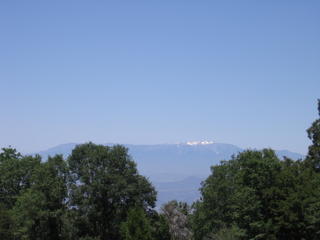
Clearly, more visitors than anticipated attended and there were a couple problems as a result. There weren't sufficient bathrooms around the grounds for the number of people who came. Also waits to see the 200 inch Hale telescope got very long. I waited over 3 hours to see the scope and only got in when the organizers decided to just let people in to guide themselves around the scope at the end of the day. For most of the day smaller groups were allowed in at a time and given a more guided tour. The scope is impressive enough as it is and with people stationed around the inside to answer questions, a guided tour would not really be necessary. But the positives far outweighed the negatives and credit is due to the observatory, CalTech, and to the Friends of the Palomar Observatory (website here) for opening the grounds to the public.
Here are some final miscellaneous photographs.
-tdr
Top left photo: Some staff of the observatory live on the grounds. This is a pet cat roaming around the interferometer. Top right photo: This is a small part of the line to get into the Big Eye. The local fire department was on hand with their equipment.


Middle left photo: The San Diego Astronomy Assocation (website here) had some scopes set up to view the sun at the 60 inch scope. Middle right photo: The view from the observatory's 5,000 foot elevation is impressive.


Bottom photo: As the globe warms, some mountains in Southern California remain snowcapped in June.

Labels: Palomar Open House 2005
Oh, It's Not An Interoceter; It's An Interferometer.
It was every exciting when the Mt. Palomar Observatory announced it would open its interoceter for public viewing. As any fan of 1950s science fiction movies knows, the interoceter is a machine from Metaluna, a planet inhabited by humanoids with really big foreheads and cool names like, "Exeter." In the classic movie, This Island Earth, the Metalunans send the plans and parts to build an interoceter to scientists on Earth as a test of intelligence. (Click here for IMDB webpage on movie and photos.) The scientists who successfully build an interoceter, Americans natch, are then recruited by the Metalunans to leave Earth and help them fight a war on their home planet. The movie is a cold war parable whose moral escapes me at the moment but it was probably something about the dangers of nuclear weapons, or science in service to militarism, or demonizing your enemies, or perhaps all three. It's a decent flick that has unfortunately been mercilessly skewered by Mystery Science Theater 3000.
I don't quite remember what an interoceter is or what it is supposed to do. I think it may have been some kind of subspace radio. It doesn't matter though, since Palomar either doesn't have one or they are still keeping it a secret from the public. Instead, they proudly opened their Palomar Testbed Interferometer to the public at the Open House.
The PTI is much different from the other scopes at the observatory. For one, it's not housed in a large dome like the others are. For two, it's not a single large scope but an array of smaller scopes that work in tandem to give the resolution of a much larger telescope.
The PTI's three 16 inch telescopes are housed in three small sheds separated by 110 meters.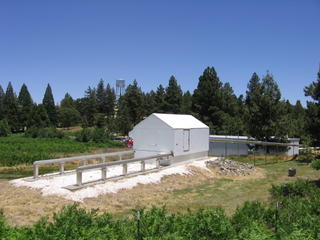
When the scopes are operating the sheds roll back on tracks to expose them to the night sky.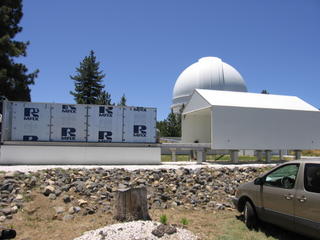
The scopes are linked by vacuum tunnels to a central building.
The central building houses two mirrors on carts that move in tandem with the telescopes during operation. The light collected by the three small scopes is directed down the vacuum tunnels to the central mirrors, where the light is blended into a wave form that is captured by a special camera.
Because the scopes are each only 16 inchers they are not able to capture much light.
However, because they work in tandem and their light is blended in the central building they can duplicate the resolution of a much larger scope: about 4300 inches (110 meters) compared to Big Eye's 200 inches according to an astronomer at the Open House.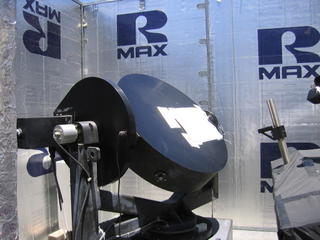
The PTI is thus able to measure objects with an accuracy unmatched by any other scope at the observatory. As one of the astronomers explained, the PTI could view an egg all the way across the United States in New York City and be able to tell which end of the egg was up. A neat parlor trick that would be.
The PTI was the first scope to accurately measure a star other than Sol. In this case, Altair, which turned out to be two times larger than Sol but spinning 600 times faster.
Today PTI is funded and managed by the Michelson Science Center. (Click here for Palomar's PTI webpage.) It is used to detect and measure the orbits of binary stars with very precise accuracy. It is also used to observe very young stellar objects. By observing these stellar infants, very much like Sol in its infancy, astronomers hope to learn about the early life of stars and about the disk material that surrounds stars and eventually forms planets.
-tdr
I don't quite remember what an interoceter is or what it is supposed to do. I think it may have been some kind of subspace radio. It doesn't matter though, since Palomar either doesn't have one or they are still keeping it a secret from the public. Instead, they proudly opened their Palomar Testbed Interferometer to the public at the Open House.
The PTI is much different from the other scopes at the observatory. For one, it's not housed in a large dome like the others are. For two, it's not a single large scope but an array of smaller scopes that work in tandem to give the resolution of a much larger telescope.
The PTI's three 16 inch telescopes are housed in three small sheds separated by 110 meters.

When the scopes are operating the sheds roll back on tracks to expose them to the night sky.

The scopes are linked by vacuum tunnels to a central building.

The central building houses two mirrors on carts that move in tandem with the telescopes during operation. The light collected by the three small scopes is directed down the vacuum tunnels to the central mirrors, where the light is blended into a wave form that is captured by a special camera.
Because the scopes are each only 16 inchers they are not able to capture much light.

However, because they work in tandem and their light is blended in the central building they can duplicate the resolution of a much larger scope: about 4300 inches (110 meters) compared to Big Eye's 200 inches according to an astronomer at the Open House.

The PTI is thus able to measure objects with an accuracy unmatched by any other scope at the observatory. As one of the astronomers explained, the PTI could view an egg all the way across the United States in New York City and be able to tell which end of the egg was up. A neat parlor trick that would be.
The PTI was the first scope to accurately measure a star other than Sol. In this case, Altair, which turned out to be two times larger than Sol but spinning 600 times faster.
Today PTI is funded and managed by the Michelson Science Center. (Click here for Palomar's PTI webpage.) It is used to detect and measure the orbits of binary stars with very precise accuracy. It is also used to observe very young stellar objects. By observing these stellar infants, very much like Sol in its infancy, astronomers hope to learn about the early life of stars and about the disk material that surrounds stars and eventually forms planets.
-tdr
Labels: Palomar Open House 2005
Thursday, June 30, 2005
Comets, Asteroids, And Brown Dwarfs, O My!
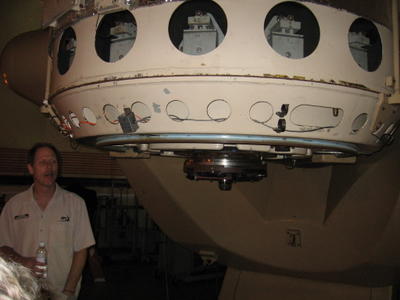
The 200 inch Big Eye is the signature scope at Mt. Palomar (click here for website) but there are other scopes at the observatory that contribute as much or more to science. They are just a lot smaller. For instance, there's the next largest scope, the 60 inch "Pig Eye." (The photo above is the scope's base.)
Besides rhyming with Big Eye, the 60 inch scope's nickname, Pig Eye, is an affectionate reminder of its origin. The scope was donated to the observatory in 1970 by the Oscar Mayer Company at a ceremony attended by the company's namesake. Who knew the company was named after an actual person? (Here's a full picture of the scope.)
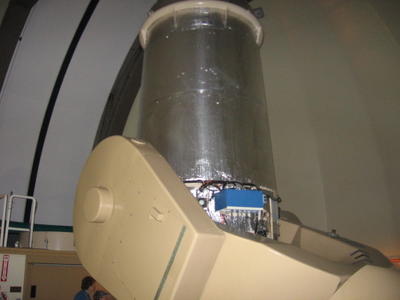
Pig Eye's most notable achievement came in 1994 with the discovery of the first brown dwarf, Gliese 229B, located 19 light years from Sol in the Gliese 229 system. The brown dwarf is 20 to 50 times more massive than Jupiter, too big and hot to be a planet but too small and cool to be a star. (Click here for more info on these unusual heavenly bodies.)
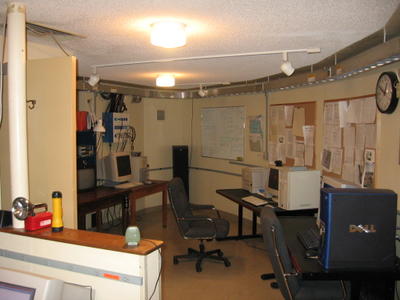 Pig Eye is mostly used to observe planets within the Heliosphere and distant planetary nebulae. The 60 inch scope has only a 4 month waiting list for use as opposed to the 200 inch scope's 4 year wait. The small room (pictured at left) on the second floor of the dome is the control room.
Pig Eye is mostly used to observe planets within the Heliosphere and distant planetary nebulae. The 60 inch scope has only a 4 month waiting list for use as opposed to the 200 inch scope's 4 year wait. The small room (pictured at left) on the second floor of the dome is the control room.It's not always used because Pig Eye can be operated remotely. It recently had a new operating system and camera installed so that astronomers at Cal Tech and elsewhere could use the scope without having to make the long trip to Mt Palomar.
Another scope at the observatory is the 48 inch Samuel Oschin. (The scope's dome is pictured at right.) The dome looks like any other dome at the observatory but the scope inside is very important to the safety of all humankind.
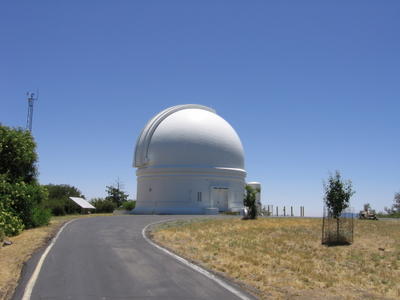
The Samuel Oschin is used in the Near Earth Asteroid Tracking project (NEAT, click here for website)
The NEAT project tracks the asteroids that circle the Earth near the Earth's orbit. There are 3440 know asteroids whose orbits are near to Earth's. In 1900 only 18 had been discovered. NEAT's goal is to find 90 percent of the near-Earth asteroids with diameters greater than 1 kilometer by 2008. An asteroid of that size could cause really serious problems for humans if it were to collide with the Earth. So every night the Samuel Oschin takes 200 pictures of the night sky with its 16 megapixel camera and computers compare the photographs against images of known fixed stars in the sky. The extra specks of light in the photographs are the asteroids. NEAT astronomers then track these asteroids to plot their orbits to determine whether any of them pose a risk of collision now or into the future.
Another scope on site is the 18 inch Schmidt. The Schmidt is the oldest scope at the observatory. It became operational in 1936. Its most notable achievement was the discovery of Shoemaker-Levy. In its history the scope discovered 50 comets but it is no longer used for scientific research. (The Schmidt's dome is pictured below.)
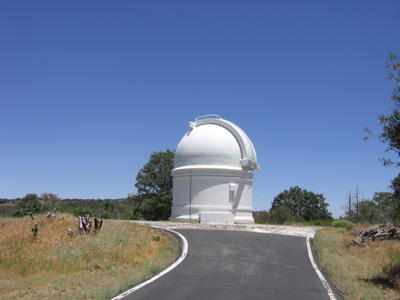
Come back tomorrow for more Open House photos.
-tdr
Labels: Palomar Open House 2005
Tuesday, June 28, 2005
Photos Of The "Big Eye" At Mt. Palomar Observatory.
The Mount Palomar Observatory (website here) had its first-ever open house on June 25, 2005. Although the observatory is open to the public every day, for the first time at the open house visitors were able to go inside the domes of two of the observatory's telescopes, including "The Big Eye," as they call the 200 inch scope. The photos that follow are the first in a series taken at the open house. Today's photos are of the 200 inch telescope. Unfortunately, the quality of these photos is probably the worst in the series. It was very dark inside the dome. (A suggestion for next year's open house. Turn up the lights.) Other photos this week will include two other telescopes and some shots of the compound and the open house. They will be much clearer. I promise. The first photo below is of Big Eye's dome.

The large telescope's dome is the dominant feature on the 200 acre observatory site. The dome is 135 feet tall by 137 feet in diameter and weighs 1,000 tons. From a distance the dome is obviously a large structure. But it's a close-up view that drives home the dome's enormous size. The picture below shows just how big the dome is. Note the tiny people walking along the catwalk that encircles the dome.
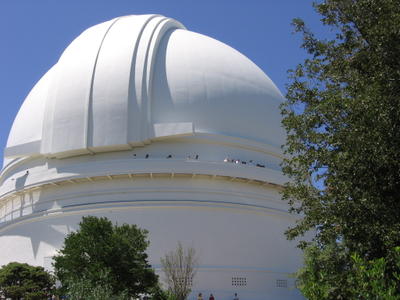
Big Eye's enormous size is revealed inside the dome where the scope has made its home since 1948. The scope is so large that a small cage-enclosed control room is attached to the bottom it. The control room hangs about 8 feet or so above the floor. The picture below is a shot of the bottom of the scope and the cage hanging above the floor.
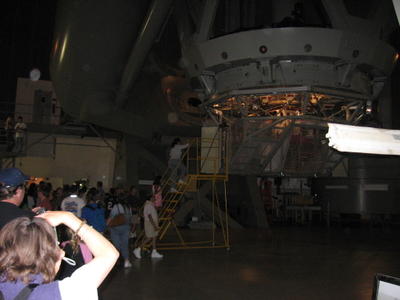
Most telescopes give the impression of fragility. Not this one. Big Eye's 200 inch mirror alone weighs 40 tons. Its huge size requires massive machinery to move it about inside the dome and position it for viewing. The impression is not of a delicate instrument at all. Instead the scope's steel framework and machinery creates an impression of massive strength. Almost like a very large cannon. This next picture was taken from the floor and shows part of the mechanism that controls the scope's movement.

This next picture was taken from an inside second-story catwalk and shows more of the machinery that holds the scope and moves it around.
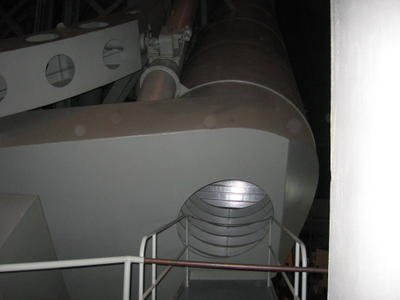
This picture is once again taken in near darkness. It's also taken from the second story catwalk. It shows the scaffolding that holds the telescope nestled in the machinery. You can click on the image to increase its size. With luck this may make it easier to view.
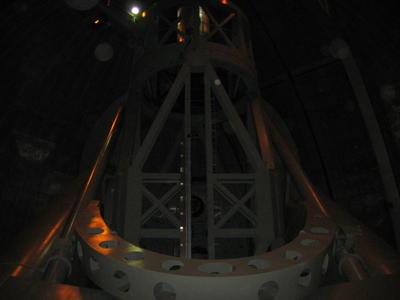
Back on the floor for a shot of the astronomers in the cage preparing for the night's viewing. There's up to a four-year waiting list for telescope time on Big Eye. Bad weather or technical difficulties can ruin an observation run. There's no do-overs, either. If the run is ruined the astronomers have to get back on the waiting list and hope that next time the weather is clear. The weather was good on this day so nobody in the control cage appeared particularly nervous. They were spending a lot of time huddled around the computers, however.

Like any machine the 200 inch telescope at Palomar needs maintenance. The mirror has to be cleaned and re-aluminized every two years or so. (Click here for website showing that process.) Besides the telescope and its machinery, there were two structures used in the aluminizing process. The first picture shows the unit that holds the mirror when it is removed from the scope for cleaning.

This next picture shows the re-aluminizing unit. During re-aluminization the 17.5 ton unit is lifted by a crane to the top of the unit holding the mirror. Air is evacuated and tungsten coils with aluminum draped on them are heated, which vaporizes the aluminum and coats the mirror leaving it shiny and new. The mirror just happened to have been re-aluminized the week before the open house.

Finally, the picture below shows a small replica of the 200 inch telescope. The replica is controlled by an electric motor that visitors can operate to learn how the scope moves. Unfortunately, this is probably the best photograph of what the scope looks like that I was able to take.
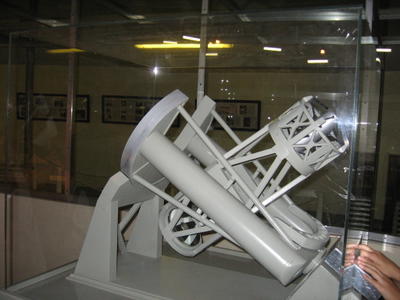
That's it for today's photographs. Come back again for others, including the 60 inch scope, the Palomar Testbed Interferometer, and more.
-tdr

The large telescope's dome is the dominant feature on the 200 acre observatory site. The dome is 135 feet tall by 137 feet in diameter and weighs 1,000 tons. From a distance the dome is obviously a large structure. But it's a close-up view that drives home the dome's enormous size. The picture below shows just how big the dome is. Note the tiny people walking along the catwalk that encircles the dome.

Big Eye's enormous size is revealed inside the dome where the scope has made its home since 1948. The scope is so large that a small cage-enclosed control room is attached to the bottom it. The control room hangs about 8 feet or so above the floor. The picture below is a shot of the bottom of the scope and the cage hanging above the floor.

Most telescopes give the impression of fragility. Not this one. Big Eye's 200 inch mirror alone weighs 40 tons. Its huge size requires massive machinery to move it about inside the dome and position it for viewing. The impression is not of a delicate instrument at all. Instead the scope's steel framework and machinery creates an impression of massive strength. Almost like a very large cannon. This next picture was taken from the floor and shows part of the mechanism that controls the scope's movement.

This next picture was taken from an inside second-story catwalk and shows more of the machinery that holds the scope and moves it around.

This picture is once again taken in near darkness. It's also taken from the second story catwalk. It shows the scaffolding that holds the telescope nestled in the machinery. You can click on the image to increase its size. With luck this may make it easier to view.

Back on the floor for a shot of the astronomers in the cage preparing for the night's viewing. There's up to a four-year waiting list for telescope time on Big Eye. Bad weather or technical difficulties can ruin an observation run. There's no do-overs, either. If the run is ruined the astronomers have to get back on the waiting list and hope that next time the weather is clear. The weather was good on this day so nobody in the control cage appeared particularly nervous. They were spending a lot of time huddled around the computers, however.

Like any machine the 200 inch telescope at Palomar needs maintenance. The mirror has to be cleaned and re-aluminized every two years or so. (Click here for website showing that process.) Besides the telescope and its machinery, there were two structures used in the aluminizing process. The first picture shows the unit that holds the mirror when it is removed from the scope for cleaning.

This next picture shows the re-aluminizing unit. During re-aluminization the 17.5 ton unit is lifted by a crane to the top of the unit holding the mirror. Air is evacuated and tungsten coils with aluminum draped on them are heated, which vaporizes the aluminum and coats the mirror leaving it shiny and new. The mirror just happened to have been re-aluminized the week before the open house.

Finally, the picture below shows a small replica of the 200 inch telescope. The replica is controlled by an electric motor that visitors can operate to learn how the scope moves. Unfortunately, this is probably the best photograph of what the scope looks like that I was able to take.

That's it for today's photographs. Come back again for others, including the 60 inch scope, the Palomar Testbed Interferometer, and more.
-tdr
Labels: Palomar Open House 2005
Thursday, June 23, 2005
Palomar Observatory Open House

This Saturday, June 25, 2005, I'll be attending the open house at Mt. Palomar Observatory in the mountains east of San Diego. Look for pictures and stories on this website next week. This photo is taken from the Palomar Observatory home page. For more information on the open house go to http://www.astro.caltech.edu/palomarnew/friends/openhouse.html.

Labels: Palomar Open House 2005
